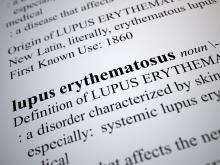Patients with systemic lupus erythematosus (SLE) who were hypocomplementemic and anti–double-stranded DNA (anti-dsDNA) positive took weekly subcutaneous belimumab in addition to their standard therapy and saw reduced disease activity and fatigue at 1 year, compared with patients taking a placebo, according to results of a phase 3, double-blinded study. These results suggest the subcutaneous version of the monoclonal antibody therapy could be administered at home without patients visiting a hospital, the investigators wrote in Arthritis and Rheumatology.
“Intravenous administration of belimumab is an obstacle to treatment for many patients due to the need to go to the hospital for drug infusions. Thus, a higher number of patients could benefit from this treatment,” Andrea Doria, MD, from the University of Padua (Italy) stated in a press release.
Dr. Doria and his colleagues randomized 356 patients with SLE who were hypocomplementemic (low C3 [less than 90 mg/dL] and/or low C4 [less than 10 mg/dL]) and anti-dsDNA+ (greater than or equal to 30 IU/mL) to receive weekly subcutaneous belimumab (200 mg) or placebo in a 2:1 allocation ratio in addition to standard SLE therapy. Patients had moderate to severe SLE as determined by a Safety of Estrogens in Lupus Erythematosus National Assessment–Systemic Lupus Erythematosus Disease Activity Index (SELENA-SLEDAI) score of 8 or higher.Researchers set a primary endpoint of response rate according to SLE Responder Index (SRI4), no new British Isles Lupus Assessment Group organ domain A or B scores, and less than a 0.3 increase in Physician’s Global Assessment score at 52 weeks, compared with baseline scores; the secondary endpoints included corticosteroid use reduction between week 40 and week 52 of 25% or more to 7.5 mg/day or less, change in Functional Assessment of Chronic Illness Therapy–Fatigue score, and measurement of time to severe flare as measured by the SLE Flare Index.
At 52 weeks, 64.6% of patients in the belimumab group responded according to SRI4, compared with 47.2% of patients in the placebo group (P = .0014). The researchers attributed the high SRI4 response rate for the placebo group to “administration of SoC [standard SLE therapy]; increased chance of receiving active treatment due to the unbalanced randomization schedule, thereby resulting in a psychological benefit; and the high frequency of visits and patient satisfaction associated with clinical trials.”
Patients had lower flare rates according to the SLE Flare Index in the belimumab group (31.5%), compared with placebo (14.1%), and those in the former group had a 62% reduction in severe flares, compared with the placebo group (hazard ratio, 0.38; 95% confidence interval, 0.24-0.61; P less than .0001). More patients taking belimumab reduced their use of corticosteroids (20.7%) than did those taking the placebo (11.4%) (odds ratio, 2.08; 95% CI, 0.91-4.77; P = .0844). Of patients taking belimumab, 44.8% had a Functional Assessment of Chronic Illness Therapy–Fatigue score of 4 or higher at week 52, compared with 33.3% of patients taking placebo (OR, 1.82; 95% CI, 1.10-3.01; P = .0199).
Regarding adverse events, there were 88 (81.5%) adverse events in the placebo group, with 29 (26.9%) of those events considered to have occurred during treatment, compared with 79 of 194 (31.9%) adverse events attributed to treatment in the belimumab group. The researchers reported 25 patients in the placebo group (23.1%) and 33 patients in the belimumab group (13.3%) had serious adverse events. Postinjection systemic reactions occurred in 21 patients (8.5%) and 13 patients (12.0%) in the belimumab and placebo groups, respectively.


